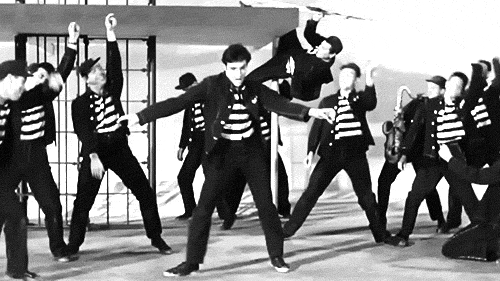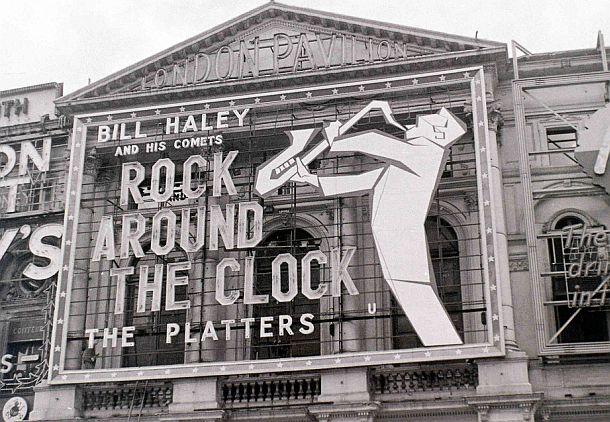From all the way back to its earliest days, rock ‘n’ roll has been almost as much of a visual medium as an audio one. First, second, and even third generation fans, when asked about the pioneering days, will likely mention Elvis Presley’s gyrating hips, Chuck Berry’s duckwalk or Jerry Lee Lewis attacking his piano. Right from the get-go, the look of rock was closely tied to the impact of the music. In the 1950s the “jukebox movies” starting arriving almost as soon as the genre had a name. Rock Around the Clock, Don’t Knock the Rock, Rock Baby Rock It, Rock Rock Rock and Jailhouse Rock all saw release by the end of 1957. These teen movies were usually uneasy alliances of the new youthful spirit of the times and hackneyed Hollywood plot points featuring head-scratching adults. The wild dancing, the Alan Freed cameos and the spotlight performances by everyone from Elvis to Johnny Burnette to LaVern Baker and the Platters, give these films a certain historical value—if you can sit still through the wooden acting and tired show-biz scenarios.
Take Rock Around the Clock. Considered by many the first rock ‘n’ roll hit, it makes sense that Columbia Pictures would build a movie around it, right from the get go. In fact, the song had already played over the opening titles of 1955’s Blackboard Jungle and would later perform the same service for 1973’s American Graffiti and the hit TV series Happy Days. The plot is a very fanciful notion of a rock & roll origin story. Big band manager Steve Hollis (played by Johnny Johnston) is convinced that the music he is promoting is on the way out and he heads back to the big city with his aptly-named sidekick, Corny. They stop in a hick town called Strawberry Springs, where is just so happens that a rock ‘n’ roll subculture (led by the local house band, Bill Haley and His Comets) is taking hold. At first they are flummoxed (“Hey, sister, what’s that exercise you’re getting?”) but soon realize they may be on to the next big thing.
All this looks so squeaky clean, making the scandalized reactions of the town’s old hags even more unintentionally funny. The dancing is energetic but hardly an affront. Everyone’s in evening wear and the action on the dance floor is led by professional partners Lisa Gaye and Earl Barton. It is Gaye’s character who gets romantically involved with Steve Hollis, enraging the Ice Queen NY booking agent who has a thing for Hollis and who is liable to destroy everyone’s chance at rock ‘n’ roll immortality, just for revenge. (Spoiler Alert: Hollis calls in a favor with Alan Freed, playing himself).
While the actors and the dancers in Rock Around the Clock are reliably Caucasian, the roll call of musicians and singers are a welcome mix of white, black and Hispanic performers. They all appear together in a final stage number. This diversity of performers (some of them true rock innovators) is the best legacy of these early pictures, even though they are cobbled together with the studio’s play-it-safe scenarios.
The Platters with their classic “Only You.”
For instance, Rock, Rock, Rock! starts out with two swingin’ numbers. One is over the opening credits where the featured performers are shown (Chuck Berry, La Vern Baker, the Moonglows, Frankie Lymon and the Teenagers etc.) and another for a dance scene at the malt shop. But the air quickly goes out of the room (cinematically speaking) when Dori (Tuesday Weld, only 13 at the time) is asked if some boy has asked her to the (middle school?) prom. After replying “not yet” she is quickly compelled to leave her seat and regale us with a soapy ballad. But naturally, the various acts lip-syncing to their hits is the big feature here, a highlight being the two numbers by Frankie Lymon and the Teenagers, seen below.
Frankie Lymon and the Teenagers, introduced by Alan Freed, in “Rock, Rock, Rock!”
And so the formula went. These jukebox pictures made for good business, so were churned out on a set schedule. Don’t Knock the Rock followed in Dec. 1956, still with Bill Haley and the Comets topping the bill (as “The Kings of Rock”) but Little Richard couldn’t help but steal the show with his two numbers towards the end of the flick.
Little Richard lets it rip with “Long Tall Sally.”
Of course, Elvis was the biggest of all back then and Colonel Parker’s scheme to make his client (and himself) rich included making as many movies as possible and Jailhouse Rock, released in fall of 1957, was already his third film vehicle. But it was the first straight-up blockbuster, both with earnings (its box office take was comparable to The Wizard of Oz) and because of its racy subject matter. As jailbird-turned-pop-star Vince Everett, Presley is a punch-happy, manslaughtering, girl-grabbing, ego-driven SOB of an anti-hero. “Cheap, unpleasant, tasteless,” were a few of the reverse compliments it earned from critics. It’s stage performance of the title song is an indelible image of the genre, despite the many far less potent films that would follow. The die had been cast and from here straight thru to Bohemian Rhapsody, the movies have been rocking ever since.
Portions of this post were taken from my book Rock Docs: A Fifty-Year Cinematic Journey. Click on the book cover above, or the link below, to see a 30-page excerpt. Thanks, Rick
https://booklocker.com/books/8905.html

